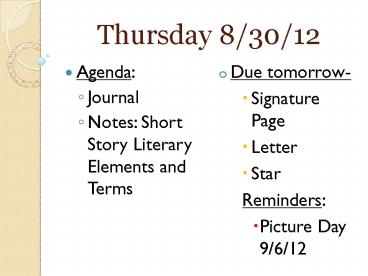Thursday 8/30/12 - PowerPoint PPT Presentation
1 / 19
Title:
Thursday 8/30/12
Description:
Thursday 8/30/12 Agenda: Journal Notes: Short Story Literary Elements and Terms Due tomorrow- Signature Page Letter Star Reminders: Picture Day 9/6/12 – PowerPoint PPT presentation
Number of Views:87
Avg rating:3.0/5.0
Title: Thursday 8/30/12
1
Thursday 8/30/12
- Agenda
- Journal
- Notes Short Story Literary Elements and Terms
- Due tomorrow-
- Signature Page
- Letter
- Star
- Reminders
- Picture Day 9/6/12
2
Journal 8/30/12
- Listen to the song. What is something about our
world that you wish you could change? Do you
think this change will ever come about? If so
when and how? 6-8 sentences. - Please remember to be respectful. You dont have
to agree with everyone but you have to value
their right to an opinion.
3
Short Story Literary Elements and Terms
4
Plot
- A series of scenes that trace a conflict or
struggle between opposing forces in a story.
5
Teaching Plot Structure Through Short Stories
Plot is the literary element that describes the
structure of a story. It shows the causal
arrangement of events and actions within a story.
6
Plots can be told in
7
Plot Components
Climax The turning point or the most intense
moment of the storymentally or physically.
Falling Action The results of the decision or
action that happened at the climax.
Rising Action The series of conflicts and crises
in the story that lead to the climax.
Exposition Introduces the setting and characters
and establishes a mood. It may also reveal the
conflict or set the stage for it.
Resolution The conclusion or tying together of
any loose ends.
8
Understanding Cause Effect
- Cause is why something happens
- Effect is the result of some event or action
- Understanding cause/effect can help you
understand what happens in the plot, and why it
happens.
9
Protagonist
- The central character of the story.
- The one who initiates the action.
- The one the audience should be able to relate to.
10
Antagonist
- A person (or group/organization) who opposes the
protagonist (main character) of the story. - Often considered the villain.
11
Characterization
- The way an author reveals a characters
personality. - Direct Characterization the author tells us
directly what a character is like. - Indirect Characterization the reader has to
determine what the character is like by the
following - The characters actions
- What the character says
- Revealing the characters thoughts
- The way others react to or feel about him/her
12
Conflict
- Conflict is the dramatic struggle between two
forces in a story. Without conflict, there is no
plot.
13
Internal Conflict
- Man v. Self
- The character struggles mentally to resolve an
issue with their individual needs, desires, or
emotions
14
External Conflict
- The character struggles with an outside force.
- Man vs. Man
- Man vs. Nature
- Man vs. Society
15
Setting
- The time and location of the story.
- Writers establish setting through the following
- Details that suggest the time of day, year,
season, or historical period - Descriptions of characters, clothing, buildings,
weather, and landscapes - The writer does not always directly state the
setting.
16
Sensory Detail / Imagery
- The use of language to evoke a picture or a
concrete sensation of a person, thing, place, or
experience. - Description that appeals to the 5 human senses
- Sound
- Sight
- Smell
- Touch
- Taste
17
Mood
- Mood is the feeling or atmosphere of a piece of
writing that a writer creates for readers. - The feeling that the reader gets after reading
the piece. - Developed through a writers use of imagery and
choice of words and details.
18
Tone
- The authors attitude toward the writing
(subject, characters, or audience). - A piece of writing can have multiple tones.
- Writers achieve tone through setting and word
choice, as well as other details. - Single word examples playful, sarcastic, ironic,
critical, reverent (respectful), irreverent
(disrespectful), philosophical (truth-seeking)
19
Theme
- Insight about human life that is revealed through
the story.































